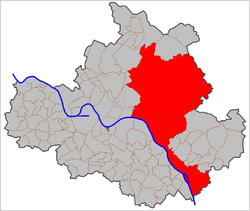Loschwitz
| Loschwitz | |
|---|---|
| Borough of Dresden | |

Schloss Albrechtsberg
|
|
| Coordinates: 51°3′49″N 13°49′18″E / 51.06361°N 13.82167°ECoordinates: 51°3′49″N 13°49′18″E / 51.06361°N 13.82167°E | |
| Country | Germany |
| State | Saxony |
| District | Urban district |
| City | Dresden |
| Area | |
| • Total | 68.83 km2 (26.58 sq mi) |
| Population (2008-12-31) | |
| • Total | 19,272 |
| • Density | 280/km2 (730/sq mi) |
| Time zone | CET/CEST (UTC+1/+2) |
| Dialling codes | 0351 |
| Vehicle registration | DD |
Loschwitz is a borough (Ortsamtsbereich) of Dresden, Germany, incorporated in 1921. It consists of ten quarters (Stadtteile):
Loschwitz is a villa quarter located at the slopes north of the Elbe river. At the top of the hillside is the quarter of Weißer Hirsch, named after a former inn erected in 1685 by the Saxon kapellmeister Christoph Bernhard, where in 1888 the naturopathic physician Heinrich Lahmann opened a sanatorium. The quarters of Wachwitz and Pillnitz are adjacent in the east and the Rosengarten park in the west. Loschwitz is connected with the borough of Blasewitz south of the Elbe by the Blue Wonder (Blaues Wunder) bridge. Furthermore, the borough encompasses large parts of the Dresden Heath, the city's forest.
The old village of Loschwitz, a wine-growing area since the 11th century, was first mentioned in a 1227 deed. About 1660 Elector John George II of Saxony had several vineyards laid out at the hillside, that soon became a fashionable recreational and residential area for the Dresden nobility and wealthy bourgeois like the composer Heinrich Schütz or the goldsmith Johann Melchior Dinglinger. The author Christian Gottfried Körner had a cottage within the vineyards, where his guest Friedrich Schiller wrote the Ode to Joy in 1785. About 1800 James Ogilvy, 7th Earl of Findlater acquired large estates, where from 1850 the Elbschlösser (Elbe Castles) were erected: Albrechtsberg Palace and Villa Stockhausen (Lingnerschloss) of Prince Albert of Prussia as well as Eckberg Castle, finished in 1861.
...
Wikipedia


